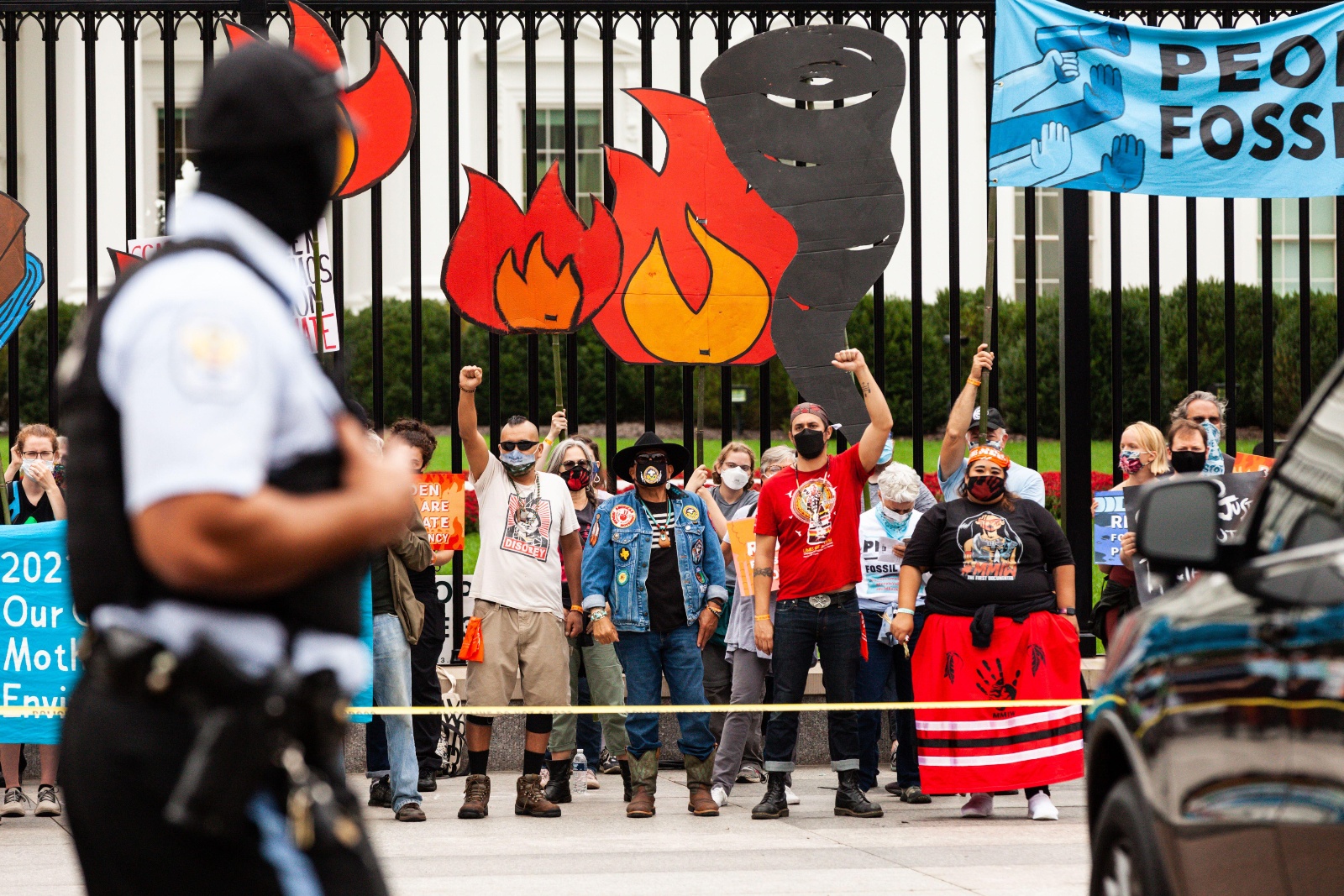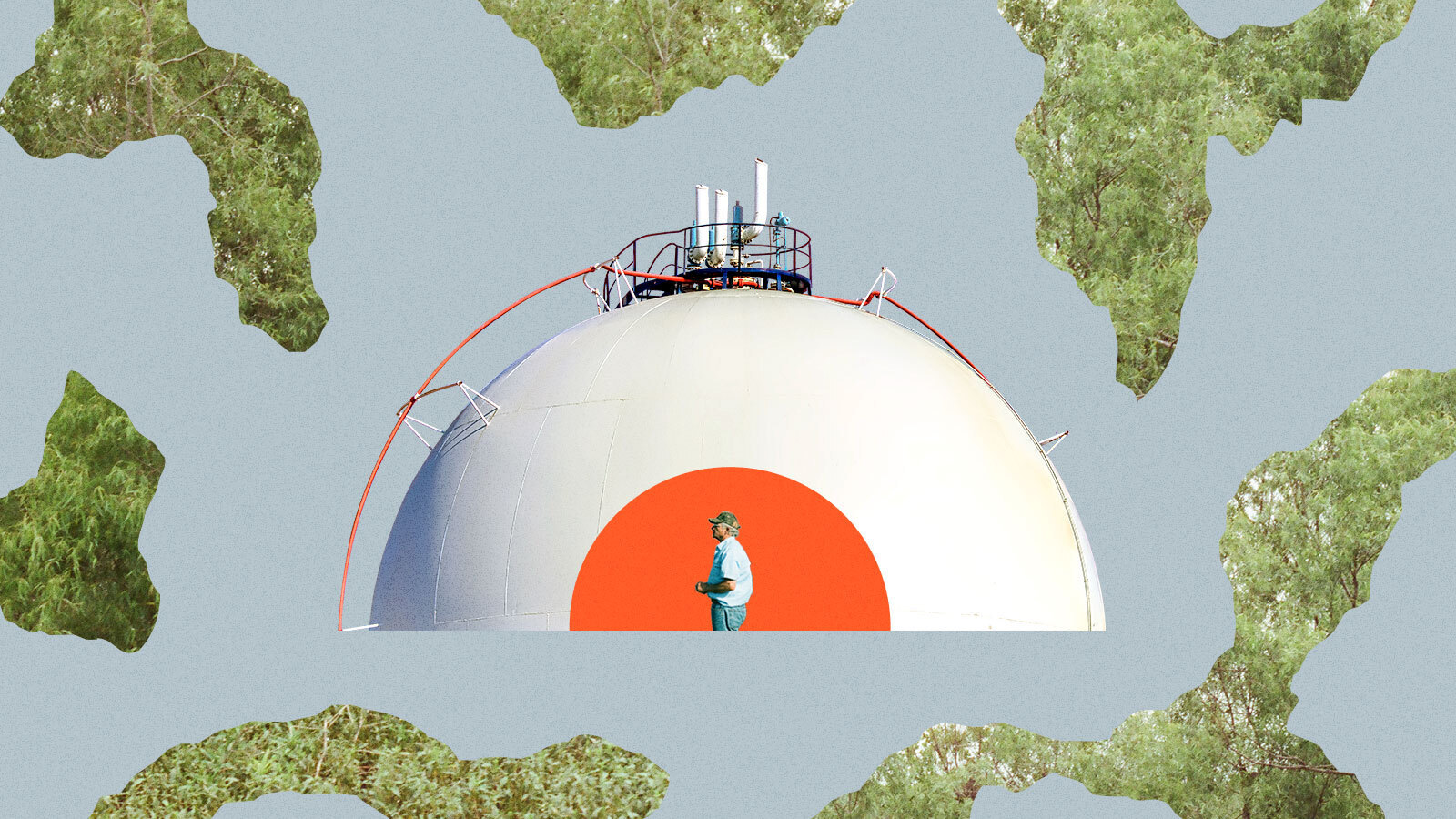This story was produced by The Bureau of Investigative Journalism and is being co-published with Grist.
Santander exploited loopholes in its own climate policy in order to help raise billions for facilities relying on fracked U.S. gas. The bank then quietly watered down the same policy, making it easier to finance fracking directly in future, The Bureau of Investigative Journalism, or TBIJ, can reveal.
The financing was for projects relating to liquified natural gas, or LNG, terminals, huge industrial plants that take gas — much of it from the region’s many fracking sites — and cool it into liquid form before loading it on to tankers to be shipped around the world.
If all the Gulf Coast’s numerous LNG projects are completed, they would form a “carbon bomb” with associated annual emissions of over a billion metric tons of CO2, more than that of Russia. Local residents have complained of air pollution, dirty water, and serious health risks for their families.
Last year, Santander was one of the banks involved in raising at least $28 billion for LNG terminals on the Texas and Louisiana coastlines. At the time, its policy prohibited the financing of projects involved in the expansion of oil and gas extraction from fracking. While the LNG projects did not directly involve fracking, they rely on fracked gas and form an essential part of the production and distribution process.
Earlier this year, Santander then changed its policy without announcing it publicly. A footnote was added to its “prohibited activities” section, stating that exceptions in relation to fracking “may be considered” subject to factors including energy security and local development.
The bank also rowed back on its acknowledgment of the “foundational” role of the Intergovernmental Panel on Climate Change, or IPCC, in international climate agreements such as the Paris Accord. The IPCC is recognized as the world’s most authoritative scientific body on the causes and consequences of climate change.
The news follows TBIJ’s revelations that Santander helped coordinate a billion-dollar bond to expand the operations of PetroPerú, a national oil company with a major pipeline slicing through vital wetlands supposedly protected by the bank’s climate policy.
Santander told TBIJ: “While we cannot comment on specific clients or transactions, all financing decisions are guided by a strict policy framework approved by our board of directors. Our lending policies are reviewed regularly by the board to ensure the bank can support clients and markets in different stages of transition and help stimulate the growth needed to enable the required investment.”
Quentin Aubineau, a policy analyst at financial campaign group BankTrack, described Santander’s policy as “highly problematic.” Its prohibited activities focus narrowly on gas extraction, he explained, but new LNG terminals — which the policy allows the financing of — require an increase in extraction to make them economically viable.
“Even if these transactions did not breach Santander’s ESG [environmental, social, and governance] policy, they highlight Santander’s lack of ambition,” he said, adding that the exclusions for some unconventional oil and gas projects are “highly insufficient.”
Ulf Erlandsson, CEO of the Anthropocene Fixed Income Institute think tank, said Santander’s lending operations looked like a “nominal breach” of its policies and had cost the bank some credibility.
He added that the bank’s practices were “largely in conjunction with a number of other European institutions with far-reaching sustainability commitments” since Russia’s invasion of Ukraine, which he said has “shifted the table on energy in Europe.”
Problematic projects
LNG development on the Gulf Coast was spurred by the country’s fracking boom in the mid-2000s, but operations have ramped up particularly again in the wake of the Russian invasion, with the U.S. moving to present itself as an alternative global source of gas. There are five terminals in operation, four more being built, and another seven that have been green-lit.
But the climate consequences are huge, and in January, Joe Biden paused the approval of any new projects.
As well as encouraging the expansion of fracking activity — a hugely polluting process that contributes to global heating — the LNG facilities that Santander has helped finance have also caused issues more locally.
The Calcasieu Pass LNG project in Louisiana, for instance, which raised a $1 billion bond with banks including Santander last year, has been linked to near-constant gas flaring, excessive emissions, and the risks of explosion. Venture Global LNG, which owns the plant, has said it is not fully operational due to faulty power equipment.
Roishetta Ozane, who lives inland from Calcasieu Pass and is Gulf fossil finance coordinator for Texas Campaign for the Environment, told TBIJ that doctors said local air and water pollution had caused an increase in her 18-year-old epileptic son’s seizures.
“He goes fishing but he can’t eat the fish,” she said. “Because I’m afraid if he gets too much mercury in his system, too much of the other pollution in the water, that is going to further exacerbate his seizures.”
Last year, Santander helped lead on a $7.8 billion finance package for the Plaquemines LNG project in Louisiana, which is poised to become one of the largest fracked gas export terminals in the U.S.
The terminal has already drawn millions of gallons of water away from the local municipal supply. Total greenhouse gas emissions from burning fracked gas as a result of expanding the terminal would be equivalent to 42 coal plants, according to an analysis by the environmental group Sierra Club.

Santander was also part of a banking collective that lent $7 billion to Port Arthur LNG, a terminal being built in southeast Texas. Bigger still was the $12 billion package for the Rio Grande terminal near Texas’ border with Mexico, which Santander was also involved in. That project is served by pipelines that pass close to Garcia Pasture, the ancestral land of the Carrizo/Comecrudo Tribe, which challenged the U.S. Federal Energy Regulatory Commission for not adequately measuring the LNG plant’s environmental impacts.
Santander told TBIJ it is “fully committed to supporting a fair and secure green transition.” It added: “We also set clear emissions reduction targets across a range of high-emitting sectors.”
Sempra Infrastructure, the company behind Port Arthur, told TBIJ it was committed to providing “secure, reliable energy” and was exploring options to lower the carbon intensity of its LNG. It said that LNG “will continue to play a key role in both developed and emerging markets worldwide.”
TBIJ made several attempts to contact Venture Global, the owner of the Calcasieu Pass and Plaquemines projects, and Next Decade, which owns Rio Grande LNG, but the companies had not responded by the time of publication.
Aubineau said Santander and commercial banks in general should not only exclude companies developing new oil and gas exploration and production from their financing policies, but the companies developing infrastructure that supports increased production too.
Erlandsson said: “With controversy also domestically on U.S. LNG terminals, to the degree that even the Biden administration has put a pause of further LNG terminal expansion, arguments that this type of financing generates material adverse effects cannot be brushed off.”
For Ozane and her community, the banks financing the LNG buildout on the Gulf Coast are deliberately putting profits over people: “While communities of color and low-income communities are fighting for our lives on the front line of climate change, these banks continue to fund the fossil fuel industries. They continue to target low-income, low-wealth Black, Indigenous, and other people of color communities, treating us like collateral damage to corporate profiteering.”
This story was originally published by Grist with the headline Santander has invested hundreds of millions of dollars in LNG buildout in the Gulf on Mar 21, 2024.
This content originally appeared on Grist and was authored by Nimra Shahid & Rob Soutar, The Bureau of Investigative Journalism.
Nimra Shahid & Rob Soutar, The Bureau of Investigative Journalism | Radio Free (2024-03-21T14:44:10+00:00) Santander has invested hundreds of millions of dollars in LNG buildout in the Gulf. Retrieved from https://grist.org/accountability/santander-investment-lng-buildout-gulf-coast/
Please log in to upload a file.
There are no updates yet.
Click the Upload button above to add an update.
